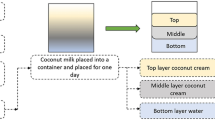Abstract
The effect of chlorophyll in photo-oxidation of virgin coconut oil (VCO) during production and storage was studied. Photo-oxidation during VCO production was performed under accelerated conditions using fluorescent lights (4,000 lux) for 8 h. Peroxide values (PVs) and chlorophyll contents of the samples were measured at 1 h intervals. To compare the photo-oxidation during storage, VCO samples were separately stored under ambient and normal room light intensity (380–400 lux) for up to 4 months and PVs were measured weekly. The results indicated that relatively low light intensity during the settling stage of VCO production had no significant effect on photo-oxidation. Photo-oxidation of VCO, however, was observed during storage when exposed to high intensity fluorescent light. The degradation of chlorophyll content in VCO was evident during exposure to a high fluorescent light intensity which was accompanied by high lipid peroxide accumulation. A significant negative correlation between PV and chlorophyll content was found in VCO without light protection. The storage of VCO significantly increased the PV after 10 weeks. This study confirmed that chlorophyll which is naturally present in VCO even at a very low level (less than 0.1 ppm) could initiate a photo-oxidation reaction leading to quality deterioration during prolonged storage or display at retailers.




Similar content being viewed by others
References
Bureau of Product Standards (BPS) (2004) Philippine National Standards: virgin coconut oil. Philippines, Department of Trade and Industry. http://www.bps.dti.gov.ph/splash.html
Scrimgeour C (2005) Chemistry of fatty acid. In: Shahidi F (ed) Bailey’s industrial oil and fat products, vol 5, 6th edn. Wiley, Hoboken, pp 1–43
List GR, Wang T, Shukla VKS (2005) Storage, handling and transport of oils and fats. In: Shahidi F (ed) Bailey’s industrial oil and fat products, vol 5, 6th edn. Wiley, Hoboken, pp 191–229
Anwar F, Chatha SAS, Hussain AI (2007) Assessment of oxidative deterioration of soybean oil at ambient and sunlight storage. Grasas y Aceites 58(4):390–395
Min DM, Boff JM (2002) Chemistry and reaction of singlet oxygen in food. Comp Rev Food Sci and Food Saf 1:58–72
Choe E, Min DB (2006) Mechanisms and factors for edible oil oxidation. Comp Rev Food Sci and Food Saf 5:169–186
Lee KH, Jung MY, Kim SY (1997) Quenching mechanism and kinetics of ascorbyl palmitate for the reduction of photosensitized oxidation of oils. J Am Oil Chem Soc 74(9):1053–1057
IUPAC (1992) Standard methods for the analysis of oils, fats and derivatives. Pergamon, New York
AOCS (2004) Official methods and recommended practices of the AOCS, 5th edn. AOCS Press, Champaign
Rahmani M, Csallany AS (1998) Role of minor constituents in the photo-oxidation of virgin olive oil. J Am Oil Chem Soc 75(7):837–843
Kim HJ, Hahm TS, Min DB (2007) Hydro-peroxide as a prooxidant in the oxidative stability of soybean oil. J Am Oil Chem Soc 84:349–355
Marina AM, Man YBC, Nazimah SAH (2009) Chemical properties of virgin coconut oil. J Am Oil Chem Soc 86:301–307
Chen BH, Liu MH (1998) Relationship between Chlorophyll a and β-carotene in a lipid-containing model system during illumination. Food Chem 63(2):207–213
Decker EA (1998) Strategies for manipulating the prooxidative/antioxidative balance of food to maximize oxidative stability. Trends Food Sci Tech 9:241–248
Byun M-W, Jo C, Lee K-H, Kim K-S (2002) Chlorophyll breakdown by gamma irradiation in a model system containing linoleic acid. J Am Oil Chem Soc 79(2):145–150
Chen BH, Huang JH (1998) Degradation and isomerization of chlorophyll a and β-carotene as affected by various heating and illumination treatments. Food Chem 62(3):299–307
Thron M, Eichner K, Ziegleder G (2001) The influence of light of different wavelengths on chlorophyll-containing foods. LWT Food Sci Technol 34:542–548
Fakourelis N, Lee EC, Min DB (1987) Effects of chlorophyll and β-carotene on the oxidation stability of olive oil. J Food Sci 52(1):234–235
Lee J, Lee Y, Choe E (2007) Temperature dependence of the autoxidation and antioxidants of soybean, sunflower, and olive oil. Eur Food Res Technol 226:239–246
Acknowledgments
This work was financially supported by research grant in 2008–2009 from the Ministry of Research and Technology the Republic of Indonesia and authors greatly appreciate the support.
Author information
Authors and Affiliations
Corresponding author
About this article
Cite this article
Rukmini, A., Raharjo, S. Pattern of Peroxide Value Changes in Virgin Coconut Oil (VCO) Due to Photo-Oxidation Sensitized by Chlorophyll. J Am Oil Chem Soc 87, 1407–1412 (2010). https://doi.org/10.1007/s11746-010-1641-7
Received:
Revised:
Accepted:
Published:
Issue Date:
DOI: https://doi.org/10.1007/s11746-010-1641-7




